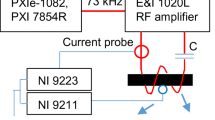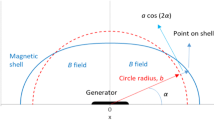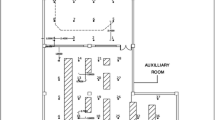Abstract
Machine-related injuries are one of the major safety concerns in underground coal mines. Severe injuries and fatalities occur when a miner is struck, crushed, or pinned by mining equipment such as a continuous mining machine (CMM), shuttle car, or a scoop. Proximity detection systems (PDSs) have been applied in mining to reduce these types of injuries and fatalities. All of the PDSs that are currently approved by the Mine Safety and Health Administration (MSHA) for use in underground coal mines are magnetic-field based and could be affected by metallic objects such as trailing cables. Researchers from the National Institute for Occupational Safety and Health (NIOSH) investigated the influence of trailing cables on the performance of PDSs. In particular, the magnetic field coupled from proximity system generators to a de-energized trailing cable was characterized. The results show that significant energy can be coupled from the proximity system generators to a trailing cable when there is a closed loop in the cable. The effect on PDS performance from the magnetic field radiated around an energized trailing cable was also quantified for different current amplitudes in the cable. It is shown that the magnetic field caused by the electric current in the trailing cable mainly consists of a 60-Hz signal and its harmonics which causes little interference to the PDS. The results presented in this paper can help PDS manufacturers to design better systems that are more immune to these effects.














Similar content being viewed by others
References
DuCarme JP, Carr JL, Jobes CC (2015) "Proximity detection with selective machine shutdown." 2015 SME annual meeting and exhibit. Society for Mining, Metallurgy, and Exploration, Inc., Preprint 15-083, Denver, pp 392–395
Jobes CC, Carr JL, DuCarme JP (2012) Evaluation of an advanced proximity detection system for continuous mining machines. Int J Appl Eng Res 7(6):649–671
Jobes CC, Carr JL, Homce GT, Smith AK (2016) "Analysis, conversion, and visualization of survey position and magnetic field strength data for a proximity detection system." SME Annual Meeting. Society for Mining, Metallurgy, and Exploration, Inc., Preprint 16-011, Phoenix, pp 1–5
Li J, Whisner B, Waynert JA (2013) Measurements of medium-frequency propagation characteristics of a transmission line in an underground coal mine. IEEE Trans Ind Appl 49(5):1984–1991
Mine Safety and Health Administration (2015) U.S. Department of Labor, proximity detection systems for continuous mining machines in underground coal mines. Fed Regist 80(10):30 CFR Part 75, MSHA-2010-0001
Molisch AF (2012) Wireless communications. John Wiley & Sons, Hoboken
Noll J, DeGennaro C, Carr J, Ducarme J, Homce G (2017) Causal factors of collision accidents involving underground coal mobile equipment Proceedings of ASME 2017 International mechanical engineering congress and exposition IMECE2017, Nov. 3-9, 2017, Florida. https://doi.org/10.1115/IMECE2017-70714
Acknowledgements
We would like to thank Bruce Whisner and Tim Lutz for their help and support with the research reported in this paper.
Author information
Authors and Affiliations
Corresponding author
Ethics declarations
Disclaimer
The findings and conclusions in this report are those of the authors and do not necessarily represent the views of the National Institute for Occupational Safety and Health. Reference to specific brand names does not imply endorsement by the National Institute for Occupational Safety and Health.
Conflict of Interest
On behalf of all authors, the corresponding author states that there is no conflict of interest.
Additional information
Publisher’s Note
Springer Nature remains neutral with regard to jurisdictional claims in published maps and institutional affiliations.
Rights and permissions
About this article
Cite this article
Zhou, C., Li, J., Damiano, N. et al. Influence of Trailing Cables on Magnetic Proximity Detection Systems. Mining, Metallurgy & Exploration 36, 277–284 (2019). https://doi.org/10.1007/s42461-019-0047-9
Received:
Accepted:
Published:
Issue Date:
DOI: https://doi.org/10.1007/s42461-019-0047-9




